Maya Manivannan 2023 -
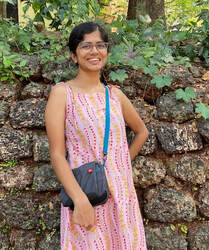
I am interested in understanding the origins and mechanisms underlying spatiotemporal patterns of biodiversity. For my Masters’ thesis at CCMB, Hyderabad, I investigated the historical biogeography of Scutigeromorph centipedes in Peninsular India. Given that the diversity of life forms is unevenly distributed across the world, I want to answer pertinent questions through the intersection of macroecology and biogeography for my PhD.
I love travelling, be it finding new nooks in my city or backpacking with my friends. I enjoy walking, running and trekking and may have a slightly unhealthy obsession with mountains.
I love travelling, be it finding new nooks in my city or backpacking with my friends. I enjoy walking, running and trekking and may have a slightly unhealthy obsession with mountains.
Geetika Aggarwal 2022 -

My master's project at IISER Mohali was an examination of the vocal repertoire and behaviors of the Large Grey babbler (LGB). LGB is a cooperatively breeding species and observing them made me realize how acoustically active species use vocalizations for maintaining group coherence and regulating activities. My interests are in ornithology, bioacoustics and group living and I would like to explore mixed species groups during my PhD.
I am passionate about dance, specifically Bhangra. I also enjoy reading and watching fiction, and as my name suggests I am a music person.
I am passionate about dance, specifically Bhangra. I also enjoy reading and watching fiction, and as my name suggests I am a music person.
Kanika Aggarwal 2022 -
I completed my Bachelors in Life Sciences from University of Delhi (2019) and Masters in Environmental Sciences from Banaras Hindu University (2021). My master’s dissertation was on understanding the effect of selective logging on the foraging behaviour of Eastern Himalayan birds. I have also worked with with MoEFCC, WWF-India and a few start-up organizations. My desire to explore more about diversity in ecosystems & associated interactions drove me here. I am broadly interested in community ecology and planning to deep dive into understanding more of its complexity for my PhD.
I am a talkative person who loves to be outdoors, traveling to new places & exploring what it holds. Birding & nature walks are my all time favorites.
I am a talkative person who loves to be outdoors, traveling to new places & exploring what it holds. Birding & nature walks are my all time favorites.
Imran Samad 2021 -

I am broadly interested in the dynamics of aquatic systems, with a focus on top trophic level species like dolphins and whales. My master's thesis at NCBS, on the Ganges river dolphin in the Farakka barrage system made me realise how interesting and different aquatic systems can be from their terrestrial counterparts, and how important it is to understand them. For my PhD I aim to broaden my scope and study megafauna in marine ecosystems and their interactions with fisheries.
I am a curious fellow who likes to read and discuss on various disciplines ranging from astronomy to philosophy. I like to spend my time travelling, writing, playing music, and simply trying not to get buried under stagnancy.
I am a curious fellow who likes to read and discuss on various disciplines ranging from astronomy to philosophy. I like to spend my time travelling, writing, playing music, and simply trying not to get buried under stagnancy.
Shawn Dsouza 2021 -

I completed my Masters in Biodiversity from Pune University in May 2017 and soon after joined Dakshin foundation where I was until February 2021. I've worked on a variety of taxa and systems in the past including birds, butterflies, sea snakes, and fisheries. However, my central interests in community ecology and human interactions with natural systems have remained more or less unchanged. I plan to work on understanding species interactions within coral reef communities and their links with the carbon cycle in the Andaman Islands.
If you don't find me staring at a screen, I'll probably be reading, playing football, or at the gym.
If you don't find me staring at a screen, I'll probably be reading, playing football, or at the gym.
Bharat Ahuja 2019 -
I am broadly interested in community ecology and how animals respond to anthropogenic stressors in their environments. For my master’s thesis, I worked on the effects of tourism on intertidal rocky shore fauna in the South Andaman archipelago. For my PhD , Kartik plans on dragging me to deeper waters where we are hoping to understand the mechanisms that initiate the formation of mixed species groups in reef fish. The plan is to explore spatial and temporal variations in these groups in the Andaman Sea and look at how reef health impacts the structure and dynamics of these groups.
When I’m not breathing compressed air underwater, you can find me training my dog to perform tasks I’m too lazy to do myself or indulging in some unhealthy fanaticism of the boys in the Anfield Red.
When I’m not breathing compressed air underwater, you can find me training my dog to perform tasks I’m too lazy to do myself or indulging in some unhealthy fanaticism of the boys in the Anfield Red.
Hugo de Souza 2018 -

My research interests lie in the fields of evolutionary ecology and biogeography. My PhD attempts to elucidate the biogeography of the Family Homalopsidae, beginning with their geographic location and time of origin. These cryptic, poorly studied wetland-dwelling snakes have the rare distinction of being semi-aquatic, allowing their ancestors terrestrial and/or aquatic modes of dispersal, thus making them ideal model systems for testing dispersal hypothesis. I intend to unravel the dispersal mode taken by members of the family at each node in their phylogeny. Finally, I then hope to understand the roles played by phylogeography, and abiotic variables in allowing these snakes to colonize the whole of South-east Asia from Pakistan to the Northern tip of Australia.
I love all things outdoors - bouldering, mountain biking, camping, and just travelling in general. When not working or involved in a sport of some sort, I can usually be found making music, reading, or talking incessantly about the joys of Japanese culture, especially manga and anime.
I love all things outdoors - bouldering, mountain biking, camping, and just travelling in general. When not working or involved in a sport of some sort, I can usually be found making music, reading, or talking incessantly about the joys of Japanese culture, especially manga and anime.
Anne Theo
Diversity and distribution of mixed-species foraging groups in the Lakshadweep Islands, India, 2021.

Groups comprised of multiple species are a very common occurrence in reef fish. These groups vary vastly in size, composition and duration of association. Despite the ubiquity of this behaviour in the reef, it is very poorly understood. I am studying mixed species grouping behaviour in reef fish in the Lakshadweep islands. The study aims to identify the species that participate in these groups and examine their interactions with each other. I am also interested in exploring spatial and temporal variation in grouping behaviour across the islands. In some sense, I have always wanted to be a marine biologist. In school, I had an inclination to biology and a deep sense of wonder and fascination when it came to oceans. And now, I’m lucky enough to be doing just that. I also love all kinds of sports and outdoor activities, gardening and science fiction.
ANNE THEO SADLY PASSED AWAY IN FEBRUARY 2023. READ MORE ABOUT HER HERE.
ANNE THEO SADLY PASSED AWAY IN FEBRUARY 2023. READ MORE ABOUT HER HERE.
Priti Bangal
Understanding Rules of Assembly and Species Interactions in Mixed-species Bird Flocks, 2020.

I am interested in species interactions within animal communities. Currently, I am studying interactions within mixed-species flocks of birds. My aim is to understand how seemingly different species of birds come together to form a single large unit of a mixed-species flock and how interactions within these affect participation of flock members. I am also trying to understand species roles in flocks, specifically pertaining to the intraspecifically gregarious species and sallying solitary species. I aim to determine what influences species importance in flocks and also how the costs to some species affect species participation in mixed-species flocks of birds.
Coming from a large extended-family of engineers, I was probably on my way to becoming one of them until my interest in outdoor activities like hiking - encouraged by my parents - took me to the Western Ghats. After a Bachelor’s in Microbiology, I decided that the closed lab space did not engage me as much as the outdoors. My interest in avian ecology was set once I was handed an old pair of binoculars that I inherited from my eldest cousin. It still remains one of my most treasured possessions. Read more.
Coming from a large extended-family of engineers, I was probably on my way to becoming one of them until my interest in outdoor activities like hiking - encouraged by my parents - took me to the Western Ghats. After a Bachelor’s in Microbiology, I decided that the closed lab space did not engage me as much as the outdoors. My interest in avian ecology was set once I was handed an old pair of binoculars that I inherited from my eldest cousin. It still remains one of my most treasured possessions. Read more.
DK Bharti
Dispersal patterns and processes in Littorinid snails along the Indian coastline, 2019.

I am interested in marine snails that are found in the interface of land and sea. As adults these are very restricted in their movement but produce larvae which can traverse surprisingly distances. These larvae ride ocean currents and can drift several hundred kilometers before finding a suitable spot and growing to be a sedentary adult. For my PhD, I studied how different populations of these snails are related to each other using tools in genetics, and interpreted these patterns in the light of habitat distribution and ocean currents. My research focused on snails from the family Littorinidae and Conidae and took me to rocky shores, mangroves and subtidal habitats.
I come from a background in microbiology and genomics and was drawn to ecology from a sense of wonder for the natural world – the diversity of living organisms and their quirky adaptations. I also like writing about science and the people behind it, and have written news pieces for the Science Media Center, and contributed news, features and interviews for the CONNECT magazine based IISc. I am also a Japanophile.
I come from a background in microbiology and genomics and was drawn to ecology from a sense of wonder for the natural world – the diversity of living organisms and their quirky adaptations. I also like writing about science and the people behind it, and have written news pieces for the Science Media Center, and contributed news, features and interviews for the CONNECT magazine based IISc. I am also a Japanophile.
Varun Torsekar
Lineage delimitation and diversification in Nyctibatrachus, an endemic frog genus from the Western Ghats, 2019.

I am working on the evolutionary history of the frog genus Nyctibatrachus from the Western Ghats. This genus is an ancient frog lineage that has undergone extensive radiation in the Western Ghats and does not have any close relatives in any other part of the Asian mainland. Its endemism, extreme homology, ancient history, extensive diversification and interesting pattern of distribution make it a particularly suitable model system for examining the process of diversification. My work deals with the following objectives: delimiting species, examining patterns of distribution and adaptive/non-adaptive radiation, investigating role of geological/ecological factors in causing diversification and finally, determining modes of speciation in Nyctibatrachus.
I’ve always had a peripheral interest in the animal world. It was while pursuing my B.Sc. in Zoology from the University of Bombay that I developed an interest in ecology and realized that I could actually pursue wildlife biology as a career. Following a M.Sc. in Widlife Science from WII, Dehradun, I joined the PhD program at CES in 2008. My hobbies include philately, horology and quizzing.
I’ve always had a peripheral interest in the animal world. It was while pursuing my B.Sc. in Zoology from the University of Bombay that I developed an interest in ecology and realized that I could actually pursue wildlife biology as a career. Following a M.Sc. in Widlife Science from WII, Dehradun, I joined the PhD program at CES in 2008. My hobbies include philately, horology and quizzing.
Ashok Kumar Mallik
Systematics and comparative biogeography of vine snakes and pit vipers in Peninsular India, 2018.

I am interested in investigating patterns of species distribution and diversification of snakes and other herpetofauna. For my doctoral research, I worked on the morphological and genetic relationships between different species of pit vipers, vine snakes, cat snakes, keelbacks and a few other genera of snakes distributed in India, using molecular tools, and morphological and environmental variables.
I also attempted to understand how such relationships are correlated with temporal patterns of geography, ecology and environmental events. In addition, I am investigating comparative biogeography across genera, given similar historical events.
As part of my doctoral work, I described a new genus of vine snake, Proahaetulla antiqua, and I currently revising the taxonomy of the genera, Ahaetulla (vine snakes) and Trimeresurus (pit vipers) in India.
Website: https://sites.google.com/view/proahaetulla/home
I also attempted to understand how such relationships are correlated with temporal patterns of geography, ecology and environmental events. In addition, I am investigating comparative biogeography across genera, given similar historical events.
As part of my doctoral work, I described a new genus of vine snake, Proahaetulla antiqua, and I currently revising the taxonomy of the genera, Ahaetulla (vine snakes) and Trimeresurus (pit vipers) in India.
Website: https://sites.google.com/view/proahaetulla/home
Navendu Page
Species ranges, richness and replacement of trees in the evergreen forests of the Western Ghats, 2016.

I study ecological and evolutionary mechanisms responsible for generating and maintaining species diversity, mainly in terrestrial plants. My PhD focused on the ecological drivers of large-scale patterns in species ranges, richness and turnover of tropical evergreen woody plants in the Western Ghats, India. I am also interested in understanding the historical processes that have played a role in shaping the present day distribution of plants in the Indian subcontinent.
I love exploring and observing nature and wildlife. Although I am interested in a wide range of organisms, I take a special interest in plants. I am fascinated by their diversity and ubiquity. I have spent most of the last 10 years studying, documenting and photographing plants mainly across the Western Ghats but also other parts of India. When I am not observing or photographing plants, I am mostly seen playing Ultimate, a sport that I have recently developed a deep passion for. I am currently faculty at the Wildlife Institute of India, Dehradun.
I love exploring and observing nature and wildlife. Although I am interested in a wide range of organisms, I take a special interest in plants. I am fascinated by their diversity and ubiquity. I have spent most of the last 10 years studying, documenting and photographing plants mainly across the Western Ghats but also other parts of India. When I am not observing or photographing plants, I am mostly seen playing Ultimate, a sport that I have recently developed a deep passion for. I am currently faculty at the Wildlife Institute of India, Dehradun.
Sneha Vijayakumar
Understanding patterns of bird species distribution in the Western Ghats, 2015.
Understanding patterns of distribution and richness can contribute significantly to our knowledge of community assembly and macroecological patterns, as well as to the effective conservation of threatened species and habitats. My PhD used a combination of primary field data and spatial modeling techniques to understand the factors influencing the distribution of bird species at different spatial scales in the Western Ghats. Additionally, I investigated patterns in range sizes by developing bird species distribution maps.
I now work as a Scientific Editor. My role involves meticulously editing manuscripts for language, clarity, and readability to help researchers from a wide range of scientific disciplines communicate their science effectively. Even though I have transitioned out of academia, I continue to be fascinated by birds (especially hornbills) and the Western Ghats landscape. I am also keenly interested in conservation initiatives involving local communities, especially children.
I now work as a Scientific Editor. My role involves meticulously editing manuscripts for language, clarity, and readability to help researchers from a wide range of scientific disciplines communicate their science effectively. Even though I have transitioned out of academia, I continue to be fascinated by birds (especially hornbills) and the Western Ghats landscape. I am also keenly interested in conservation initiatives involving local communities, especially children.
SP Vijayakumar
Insights into an evolutionary radiation: causes and consequences of diversification in the Western Ghats Bush Frogs, 2014.
My broad area of research is at the interface of ecology, evolution and biogeography. My PhD was on the diversification of bush frogs in the Western Ghats Escarpment. My current research - focussed on amphibians and reptiles - is on the processes driving diversification and diversity patterns in clades and the effects of these - along with dispersal and ecological processes - on the spatial and temporal patterns of diversity, range evolution, faunal assembly and endemism. I rely primarily on extensive field data, but also on genetics and ecological modeling, to address questions and draw inferences about evolution, ecology and biogeography.
I started my work in the Western Ghats, but I have also worked in the Himalayas and Andaman and Nicobar Islands. During my PhD, I helped coordinate a project on the distribution of frogs, lizards and snakes across the Western Ghats, supported by CEPF. An online database and a field guide/atlas are currently in preparation. I also have a strong interest in disseminating research findings to the public.
I started my work in the Western Ghats, but I have also worked in the Himalayas and Andaman and Nicobar Islands. During my PhD, I helped coordinate a project on the distribution of frogs, lizards and snakes across the Western Ghats, supported by CEPF. An online database and a field guide/atlas are currently in preparation. I also have a strong interest in disseminating research findings to the public.
Hari Sridhar
Causes and consequences of heterospecific foraging associations in terrestrial bird communities, 2013.
Our current understanding of animal sociality comes, almost entirely, from a within-species context. However, there are many social benefits, e.g. protection from predators and finding food, which can, in principle, be obtained from conspecifics and heterospecifics. Based on our current knowledge, it seems that conspecific sociality is much more common than heterospecific sociality. But is this a real pattern? After all, most animals are surrounded by numerous potential heterospecific partners. I am trying to understand the conditions under which animals chooses heterospecifics over conspecifics as social partners.
After completing a PhD on mixed-species flocks, I spent six months at the Wisenschaftskolleg zu Berlin. I then did a postdoc in Vishwesha Guttal’s lab in the Centre for Ecological Sciences, Indian Institute of Science. I now work at the archives at NCBS. In addition to doing research, I teach a course on birds to Master’s students in Azim Premji University, edit a magazine called Current Conservation, and conduct interviews of scientists.
After completing a PhD on mixed-species flocks, I spent six months at the Wisenschaftskolleg zu Berlin. I then did a postdoc in Vishwesha Guttal’s lab in the Centre for Ecological Sciences, Indian Institute of Science. I now work at the archives at NCBS. In addition to doing research, I teach a course on birds to Master’s students in Azim Premji University, edit a magazine called Current Conservation, and conduct interviews of scientists.
